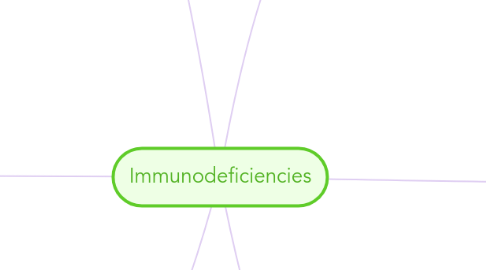
1. Antibody
1.1. Job's syndrome (hyper IgE)
1.1.1. STAT-3 def
1.1.1.1. no IFNg prod by Th1
1.1.1.2. neutrophil unresponsive to chemotactic factor
1.1.1.3. FATED: face, abscess, primary teeth, hyper-IgE, derm. problems
1.2. Extracellular and Viral - few B cells, low Ab conc all isotypes - tx: IV-Ig
1.2.1. XLA - Btk def
1.2.1.1. Underdeveloped tonsils
1.2.2. Pre-B cell receptor (Lambda5-surrogate Ig light chain)
1.3. Giardia inf.
1.3.1. selective IgA def.
1.3.1.1. Anaphylaxis after transfusion
1.3.1.2. parasites
1.3.2. CVID
1.3.2.1. most common immunodef. dx in 20's
1.4. Selective IgG def.
1.4.1. G1 - rare, bact. and viral
1.4.2. G2 - kids, encapsulated
1.4.3. G3 - adults
1.4.4. mostly IgG1 in healthy adults
1.5. hyper IgM, no other isotypes, normal B and T, extracell and opportunistic path.
1.5.1. CD40 ligand
1.5.1.1. no germinal center
1.5.1.2. intracell. bact. b/c no macrophages
1.5.2. AID
1.5.2.1. germinal centers form
2. Innate
2.1. Bacterial and Fungal
2.1.1. Neutropenia
2.1.1.1. G-CSF def.
2.1.2. Oxidative burst
2.1.2.1. Myeloperox. def.
2.1.2.2. G6P-DH
2.1.2.2.1. Anemia
2.1.2.3. CGD
2.1.2.3.1. NADPH ox
2.1.2.3.2. neg NBT, neg DHR
2.1.2.3.3. p91-PHOX
2.1.2.3.4. Serratia marcascens - skin or bone inf; Candida also common.
2.1.3. LAD
2.1.3.1. Integrin CD18 (LFA1)
2.1.3.2. Delayed umbilical sloughing
2.2. NEMO - IKKg(NFkB)
2.2.1. def. TLR signaling - innate cytokine prod.
2.2.2. bacterial and viral infections (Mycobacterium avium)
2.2.3. deep-set eyes, sparce and/or fine hair, conical or missing teeth, skin condition (blistering, color changes)
2.2.4. IV-Ig or BMT
2.3. Chediak-Higashi
2.3.1. LYST gene - vesicle formation
2.3.2. partial albanism, pyogenic infections, neurological disorders
2.3.2.1. skin and resp. tract most common inf.
2.3.3. large neutrophil granules
2.4. NK cell def.
2.4.1. perforin def. most severe
2.4.1.1. viral, MAI(opp.), Trichophyton(skin,hair,nail fungus)
2.5. Asplenia
2.5.1. encapsulated pathogens
3. T cell
3.1. Viral and some intracell.
3.1.1. TAP
3.1.1.1. No MHC-I, No CD8
3.1.2. CD8 alpha chain def. - no CD8
3.1.3. Perforin def. - non-functional CD8 and NK
3.1.4. IL-12 rec. def.
3.1.4.1. No Th1
3.2. Chronic mucocutaneous candidiasis
4. SCID
4.1. No B or T cells
4.1.1. Adenosine deaminase def. or PNP
4.1.1.1. buildup of toxic metabolites
4.2. no CD8, non-functional CD4(normal numbers)
4.2.1. ZAP70 - ITAM on CDR
4.3. no effector T cells or functional B cells (normal number B cells, reduced T cells)
4.3.1. common gamma chain def. (JAK3 signaling)
4.4. reduced T cells - no B cell activation
4.4.1. MHC-II (bare lymphocyte synd.)
4.4.1.1. No CD4 cells
4.4.2. DiGeorge Syndrome - chr. 22
4.4.2.1. Complete DiGeorge - athymia
4.4.2.1.1. No T cells
4.4.2.1.2. Thymic transplant
4.4.2.2. Developmental defects
4.5. No B cells, few T cells but autoreactive
4.5.1. Omenn syndrome
4.5.1.1. alopecia
4.5.1.2. chronic diarrhea
4.5.1.3. desquamation
4.5.1.4. partially active RAG
4.5.1.5. erythroderma, lymphadenopathy, and hepatosplenomegaly
5. B and T cell dysfunction (not SCID)
5.1. Ataxia, spider angiomas, IgA def.
5.1.1. Ataxia telengiectasia (ATM - DNA repair defect)
5.1.1.1. elevated alpha-fetoprotein
5.2. Thrombocytopenia, infections, eczema
5.2.1. Wiskott-Aldrich - cytoskeletal reorganization
5.2.1.1. T effectors can't deliver cytokines to B and Macrophages
6. Auto-immune (not SCID)
6.1. watery diarrhea, eczematous dermatitis, endocrinopathy
6.1.1. IPEX - FoxP3 defect
6.1.1.1. also display: Coombs-positive anemia, autoimmune thrombocytopenia, autoimmune neutropenia, and tubular nephropathy
6.1.1.2. Immunosuppression and BMT
6.2. APECED - AIRE expression defect
6.2.1. polyglandular symptoms, candidiasis, GI, alopecia
6.3. ALPS - Fas or caspase 10 def.
6.3.1. double neg. T cells, hemolytic anemia neutrophilia thrombocytopenia, splenomegaly
6.3.2. Immunosuppression and IV-Ig
